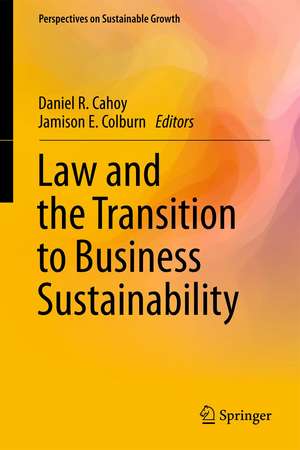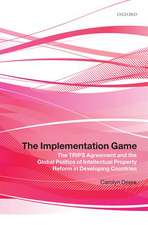Law and the Transition to Business Sustainability: Perspectives on Sustainable Growth
Editat de Daniel R. Cahoy, Jamison E. Colburnen Limba Engleză Hardback – 18 iul 2014
| Toate formatele și edițiile | Preț | Express |
|---|---|---|
| Paperback (1) | 634.18 lei 43-57 zile | |
| Springer International Publishing – 17 sep 2016 | 634.18 lei 43-57 zile | |
| Hardback (1) | 640.24 lei 43-57 zile | |
| Springer International Publishing – 18 iul 2014 | 640.24 lei 43-57 zile |
Preț: 640.24 lei
Preț vechi: 753.22 lei
-15% Nou
Puncte Express: 960
Preț estimativ în valută:
122.51€ • 128.25$ • 101.37£
122.51€ • 128.25$ • 101.37£
Carte tipărită la comandă
Livrare economică 07-21 aprilie
Preluare comenzi: 021 569.72.76
Specificații
ISBN-13: 9783319047225
ISBN-10: 3319047221
Pagini: 164
Ilustrații: XI, 153 p. 7 illus., 5 illus. in color.
Dimensiuni: 155 x 235 x 12 mm
Greutate: 0.41 kg
Ediția:2014
Editura: Springer International Publishing
Colecția Springer
Seria Perspectives on Sustainable Growth
Locul publicării:Cham, Switzerland
ISBN-10: 3319047221
Pagini: 164
Ilustrații: XI, 153 p. 7 illus., 5 illus. in color.
Dimensiuni: 155 x 235 x 12 mm
Greutate: 0.41 kg
Ediția:2014
Editura: Springer International Publishing
Colecția Springer
Seria Perspectives on Sustainable Growth
Locul publicării:Cham, Switzerland
Public țintă
ResearchCuprins
Design for Regulation: Integrating Sustainable Production into Mainstream Regulation.- Mandating Sustainability: When Federal Legislation May Preempt the Best Green Building Code Intentions.- An Operational Look at Take-Back Legislation.- Subsidizing Sustainability: The Role of the State and Civil Society in Implementing Wal-Mart’s Local Produce Sourcing Program.- IPRs and the Transfer of Technologies that Combat Climate Change: the Untapped Potential of Licensing.- The Benefits of a Sustainable Energy Trade Agreement (SETA).- The Future of Sustainability Reporting as a Regulatory Mechanism.- Green washing 2.0: Identifying a New Paradigm Through B-to-B Threat Matrices.
Textul de pe ultima copertă
This book examines the key legal and business aspects of sustainability in depth. Recognizing the firm’s need for integrated approaches to law and sustainability as well as adaptive goal setting, the book unites scholars from environmental law, energy, risk regulation and intellectual property.
Most firms now recognize that global resources are finite and will grow increasingly scarce. They acknowledge that their actions have social, economic and environmental consequences. Some firms now practice “whole life-cycle” analysis in marketing and product design, seek sustainable inputs and energy sources, and track and report sustainability performance overall, however it can be measured.
But standard practices have not kept pace. Regulators must support such efforts with mandatory structures for all firms enabling leaders to gain competitive advantages and laggards to pay the price. The variety of regulatory tools has grown to include cooperative funding, intellectual property rights, information disclosures, and other means. And that variety is most urgently needed in transition economies where the forces of international competition can be the strongest. The chapters in this book push beyond the traditional boundaries separating these dimensions of law, business and sustainability to offer both practical insights and directions for future research in this immense and growing nexus.
Most firms now recognize that global resources are finite and will grow increasingly scarce. They acknowledge that their actions have social, economic and environmental consequences. Some firms now practice “whole life-cycle” analysis in marketing and product design, seek sustainable inputs and energy sources, and track and report sustainability performance overall, however it can be measured.
But standard practices have not kept pace. Regulators must support such efforts with mandatory structures for all firms enabling leaders to gain competitive advantages and laggards to pay the price. The variety of regulatory tools has grown to include cooperative funding, intellectual property rights, information disclosures, and other means. And that variety is most urgently needed in transition economies where the forces of international competition can be the strongest. The chapters in this book push beyond the traditional boundaries separating these dimensions of law, business and sustainability to offer both practical insights and directions for future research in this immense and growing nexus.
Caracteristici
Combines theoretical and experiential accounts of firm behavior and legal regulation as they intersect Integrates insights from different bodies of law, including environmental law, energy, government regulation and intellectual property Covers a variety of geographic regions where law, sustainability and business interact


















